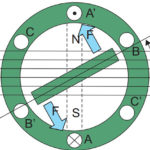BLDC motors are highly efficient and growing in use in various applications such as robotics, electric vehicles, and drones. However, to extract optimal performance from these motors, the correct commutation technique is crucial. Commutation is the process of changing the direction of the current in the motor windings, which generates torque and rotates the motor. While the basics of motor design still apply to BLDC motors, the addition of external control circuitry has created additional design considerations that engineers must account for. High on the list of considerations is how to obtain feedback for motor commutation.
The CUI Insights™ blog post, “What is the Most Effective Way to Commutate a BLDC Motor?” discusses BLDC motor commutation basics in greater detail. It takes a look at various position feedback options, including Hall effect sensors, incremental encoders, and commutation encoders, while outlining why capacitive commutation encoders can provide the best of both worlds for BLDC motor commutation.







Leave a Reply